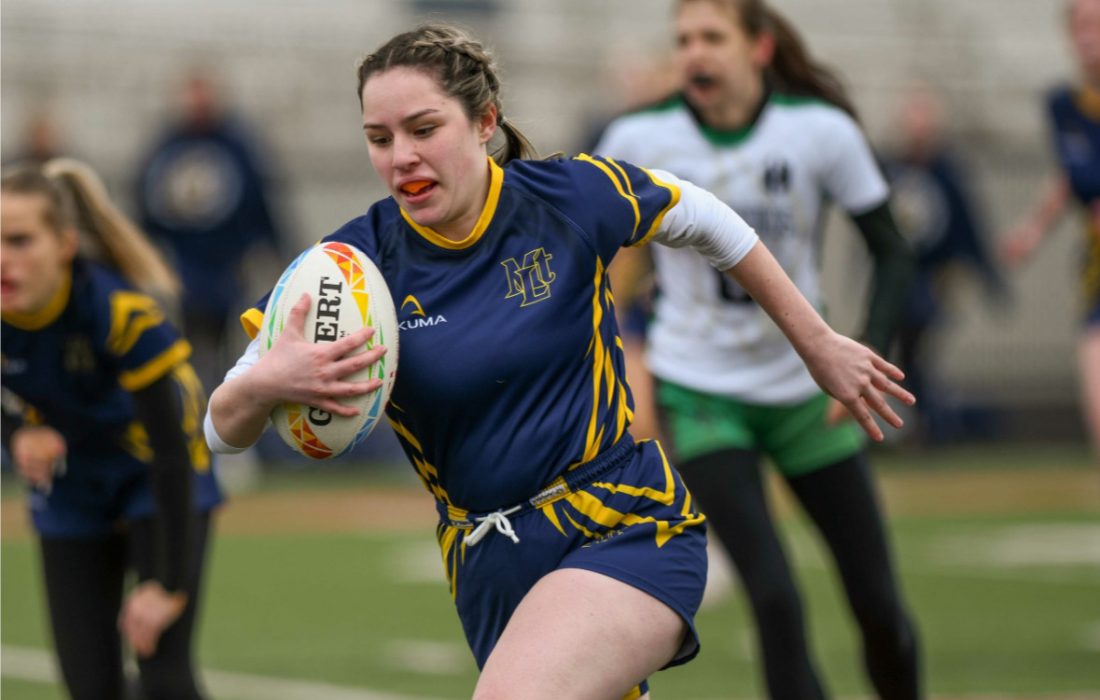Staff writer Claire Bovino reflects on her time on her high school rugby team.
Column: Women’s Rugby Isn’t Just a Sport, It’s a Lifestyle
During the winter of my junior year of high school, posters to join the school’s girl’s rugby team kept popping up around the school.
“Intro to rugby practice!” they read. “No experience needed. RSVP for a free shirt.”
I had no idea how rugby worked, but I went to practice — the best decision I’ve ever made.
By joining the team, I stepped into the cleats of the rugby women who came before me.
The very first American rugby game was played in 1874 in Boston between McGill University and Harvard University, according to Major League Rugby, before spreading from the northeast to the west by way of Texas and Utah.
Between 1905 and 1913, the U.S. began to receive visits from teams hailing from New Zealand and Australia, and won its first Olympic gold medals in rugby in 1920 and 1924.
An uproar in Paris after France’s Olympic loss in 1924 led to the U.S. team being unable to leave the arena as rugby was removed as an Olympic sport, making the U.S. the reigning champions until the sport was reinstated at the 2016 Summer Olympics in Rio.
In 2017, Major League Rugby was formed in America, with a focus on growing the sport and spreading its core values — respect, inclusivity and tradition, according to Major League Rugby.
Women couldn’t play at the collegiate level until teams began implementing Title IX in 1972. University of Colorado and Colorado State University organized the inaugural matchup, according to the United States Women’s Rugby Foundation. Colorado won the match and continued undefeated for the next two and a half years.
A decade later, the first high school women’s rugby team was recognized at St. Agnes High School in Fairfax, Va.
The U.S. and Canada competed against each other for the first time in 1987, with the U.S. dominating 22-3.
International success continued with an American capture of the first Women’s Rugby World Cup in 1991 — the same decade in which the first U.S. Women’s National 7’s Team was formed and competed in Hong Kong. By 1999, 456 women’s rugby teams had been established across the U.S.
The United Arab Emirates hosted the first Women’s World Cup (7s) in 2009, where the U.S. Women’s 3rd place accomplishment led to the establishment of the National International Rugby Association in 2015. A year later, the first women’s Olympic team was formed.
While a solid 5th place finish in Rio was great for the growth of the team, they fell to 6th place four years later in Tokyo. In the 2024 Paris Olympics, the U.S. redeemed themselves with a bronze medal after a 14-12 win over Australia.
Two hours after the bronze medal match, women’s sport investor Michella Kang pledged a donation of $4 million to Team USA. With this generous sum of money, women’s rugby underwent growth at a level they’ve never seen before.
From high school teams, to fall and spring clubs and even Junior National teams, the USA Rugby organization has aimed to cultivate the sport’s culture and its spread across the U.S.
My first season after reading those posters, I felt those three aforementioned core virtues and understood how special the culture was.
From our first practice to the last game, the team became a family. While there weren’t very many of us — only 13 or so — we made an impact. By the end of our first season, other western Pennsylvania districts were eager to start their own teams, and we had garnered enough interest to start a middle school team.
We hosted clinics, fundraisers, scrimmages and games. By the second season, the team had grown large enough for us to participate in 15-person scrimmages, giving more experience to those who hoped to pursue rugby in college.
In 1993, Loyola established a women’s rugby team, which currently competes within the Division II club level. During the fall semester, they compete in the Great Waters Women’s Collegiate Rugby Conference, and they travel around the Midwest for tournaments in the spring.
No experience is required to join the team — it’s a simple way to get your foot in the door of the rugby world and find a community for yourself.
A bond formed through women’s rugby is an unbreakable one. City-wide clubs and after-game potlucks provide chances for bonding between different teams and districts so, even on the field, everyone is connected.
I’ll always look back on my two seasons playing rugby with fondness and affection — because the sport I joined on a whim brought me joy that’ll last a lifetime.
-

Claire Bovino is a first-year student studying Political Science and Multimedia Journalism and is originally from Pittsburgh. This is her first year writing for The Phoenix. When she’s not writing or watching sports, Claire can be found reading long fantasy novels by the lake, watching new TV shows or eating hot dogs.
View all posts
Topics
Get the Loyola Phoenix newsletter straight to your inbox!


